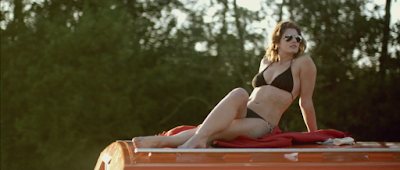Short Film #2: Jam Today (2011)
Director: Simon Ellis
Issues:
Coming of age, Sexuality, Masculinity
Themes:
Innocence, Maturity, Pride, Curiosity
At the very
beginning of the short film, the boy and his father are looking over to the
boat adjacent to it, with a woman sunbathing on top. Long takes are used to
create a relaxed mood to reflect the fact that they are on holiday. These long
takes also emphasise the silent conversation that the two men are having with
the woman, in which she acknowledges the boy and not the man. Whilst the takes are long for all three
characters, they are somewhat longer when the camera is on the woman. Laura
Mulvey’s ‘Male Gaze’ Theory can be applied to this scene, especially
considering that the woman is sunbathing in front of the men. The long takes
suggest that the men are more concerned with her than she is with them. This
supports the issues and themes surrounding sexuality, masculinity and coming of
age.
There is not much sound to be
heard at the beginning, although the non-diegetic sound picks up as the
narrative continues. This may represent the boy’s understanding of more adult
topics as his holiday proceeds. This supports the issue of coming of age, and
the themes surrounding maturity and curiosity. It may also be argued that the
lack of non-diegetic sound emphasises his boredom and deficiency in
entertainment, which exaggerates such themes.
Camera shots, angles and
movements are used to create meaning within the short to exaggerate and make
clear the themes of coming of age and curiosity. It might be noticed that the
camera shots are closer when the boy is feeling like a child, such as when he
is talking to his parents. Close ups are more common in this situation to
suggest that he is growing up and his parents are unsure as to how to treat
him. Wider, longer shots are used when the boy is exhibiting signs of curiosity
and preoccupation, which may suggest that he is exploring something new in
which there is a lot of space to learn and grow, represented by the literal space
surrounding him in the frame. This contrast of situations and shots to resemble
the confusion to be had, firstly by the boy, who is in his early stages of
puberty, and also to his parents, who are unsure of how much understanding he
has for adult themes.
The mise en scene further
emphasises the in between stage in which the boy lies, from child to
adolescent. In the beginning scene, he waves to the woman, who acknowledges him
as opposed to his father, who just smiles at her. His body language here is
childish, as he uses an enthusiastic gesture to capture her attention.
Moreover, his life jacket is large on him, which makes him appear small and
gives him a sense of youth and innocence overall. However, in this scene, he is
holding hand grips, which are used to build muscle in the arms. This may
support Lacan’s ‘Mirror Stage’ theory, in which he believes that from a young
age, children are able to recognise themselves in a mirror and change their
appearance to suit them. This displays the pressure he may feel to ‘grow up’
into his ideology of a man, which in his view, appears to be that of a
stereotypical hegemonic male. To support this view of a stereotypical male, the
tilt of the camera over the woman’s body to imitate where he is looking. This
supports the issues and themes surrounding sexuality, masculinity and maturity.
Jam Today can be applied to
Marilyn Milgrom’s The Script, as it
has a world, a character, and a problem. The world for this short is the body
of water in which the family are travelling on in their boat, and the village they’ve
stopped at. The character is the protagonist exploring aspects of the adult
world. His problem is that he wants to grow up, and build muscle to seem like a
man. Milgrom also states that one of three things must drive the character
through the narrative; a want, a need, or an obligation. In this case, the boy’s
curiosity and want to grow up is what allows the story to progress. She also
makes a point that it is important to make the end of the film meaningful by
choosing the best point of view to tell the story from. This short film
portrays the protagonist as the best point of view, as he has a realisation
toward the end that he isn’t as keen to mature as he thought he was.






No comments:
Post a Comment